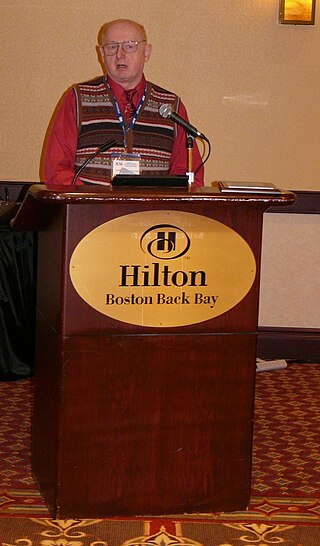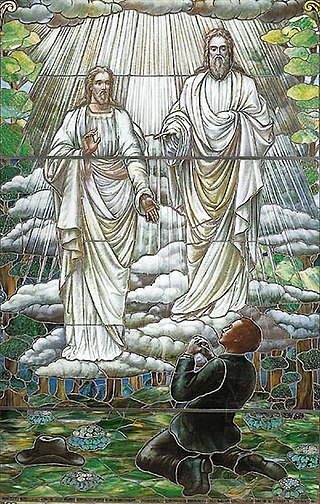
Mormonism is the religious tradition and theology of the Latter Day Saint movement of Restorationist Christianity started by Joseph Smith in Western New York in the 1820s and 1830s. As a label, Mormonism has been applied to various aspects of the Latter Day Saint movement, although there has been a recent push from the Church of Jesus Christ of Latter-day Saints to distance themselves from this label. A historian, Sydney E. Ahlstrom, wrote in 1982, "One cannot even be sure, whether [Mormonism] is a sect, a mystery cult, a new religion, a church, a people, a nation, or an American subculture; indeed, at different times and places it is all of these." However, scholars and theologians within the Latter Day Saint movement, including Smith, have often used "Mormonism" to describe the unique teachings and doctrines of the movement.

A new religious movement (NRM), also known as alternative spirituality or a new religion, is a religious or spiritual group that has modern origins and is peripheral to its society's dominant religious culture. NRMs can be novel in origin or they can be part of a wider religion, in which case they are distinct from pre-existing denominations. Some NRMs deal with the challenges which the modernizing world poses to them by embracing individualism, while other NRMs deal with them by embracing tightly knit collective means. Scholars have estimated that NRMs number in the tens of thousands worldwide, with most of their members living in Asia and Africa. Most NRMs only have a few members, some of them have thousands of members, and a few of them have more than a million members.

The Latter Day Saint movement is the collection of independent church groups that trace their origins to a Christian Restorationist movement founded by Joseph Smith in the late 1820s.
Cult is a term, sometimes considered pejorative, for a relatively small group which is typically led by a charismatic and self-appointed leader, who excessively controls its members, requiring unwavering devotion to a set of beliefs and practices which are considered deviant. This term is also used for a new religious movement or other social group which is defined by its unusual religious, spiritual, or philosophical beliefs and rituals, or its common interest in a particular personality, object, or goal. This sense of the term is weakly defined – having divergent definitions both in popular culture and academia – and has also been an ongoing source of contention among scholars across several fields of study.

Anti-Mormonism is discrimination, persecution, hostility or prejudice directed against the Latter Day Saint movement, particularly the Church of Jesus Christ of Latter-day Saints. The term is often used to describe people or literature that are critical of their adherents, institutions, or beliefs, or physical attacks against specific Saints or the Latter Day Saint movement as a whole.
Ex-Mormon or post-Mormon refers to a disaffiliate of the Church of Jesus Christ of Latter-day Saints or any of its schismatic breakoffs, collectively called "Mormonism". Ex-Mormons—sometimes referred to as exmo or postmo—may neither believe in nor affiliate with the LDS Church. In contrast, Jack Mormons may believe but do not affiliate; and cultural Mormons may or may not affiliate but do not believe in certain doctrines or practices of the LDS Church. The distinction is important to a large segment of ex-Mormons, many of whom consider their decision to leave as morally compelling and socially risky. According to 2014 Pew data, around 1/3 of adults raised LDS no longer adhere to the faith and in 2008 only 25% of LDS young adults are actively involved. Many ex-Mormons experience troubles with family members who still follow Mormon teachings. Aggregations of ex-Mormons may comprise a social movement.

David O. McKay and the Rise of Modern Mormonism is the first book to draw upon the David O. McKay Papers at the J. Willard Marriott Library, University of Utah, in addition to some two hundred interviews conducted by the authors, Gregory Prince and William Robert Wright. The work was first published on March 9, 2005, through the University of Utah Press and was met with mixed reviews.

No Man Knows My History: The Life of Joseph Smith is a 1945 book by Fawn M. Brodie that was one of the first significant non-hagiographic biographies of Joseph Smith, the progenitor of the Latter Day Saint movement. No Man Knows My History was influential in the development of Mormon history as a scholarly field, though historians of Mormonism have since criticized the book for its methodological deficiencies, factual errors, and overt hostility to Smith.
The concept of God in Abrahamic religions is centred on monotheism. The three major monotheistic religions of Judaism, Christianity, and Islam, alongside the Baháʼí Faith, Samaritanism, Druze, and Rastafari, are all regarded as Abrahamic religions due to their shared worship of the God that these traditions claim revealed himself to Abraham. Abrahamic religions share the same distinguishing features:

William Sims Bainbridge is an American sociologist who currently resides in Virginia. He is co-director of Cyber-Human Systems at the National Science Foundation (NSF). He is the first Senior Fellow to be appointed by the Institute for Ethics and Emerging Technologies. Bainbridge is most well known for his work on the sociology of religion. Recently he has published work studying the sociology of video gaming.
Danny Lynn Jorgensen is an American professor at the Department of Religious Studies of the University of South Florida, for which he also served as chair from 1999 to 2006.
Rodney William Stark was an American sociologist of religion who was a longtime professor of sociology and of comparative religion at the University of Washington. At the time of his death he was the Distinguished Professor of the Social Sciences at Baylor University, co-director of the university's Institute for Studies of Religion, and founding editor of the Interdisciplinary Journal of Research on Religion.

Encyclopedia of American Religions, renamed Melton's Encyclopedia of American Religions in the eighth edition, is a reference book by J. Gordon Melton first published in 1978, by Consortium Books, A McGrath publishing company. It is currently in its ninth edition and has become a standard reference work in the study of religion in the United States.

Armand Lind Mauss was an American sociologist specializing in the sociology of religion. He was Professor Emeritus of Sociology and Religious Studies at Washington State University and was the most frequently published author of Sociology works on Mormons during his long career. A special conference on his work in Mormon studies was held in 2013 at California's Claremont Graduate University (CGU), the papers from which were subsequently published by the University of Utah Press in the format of a Festschrift, where he was honored as "one of the most prominent Mormon intellectuals of the late twentieth and early twenty-first centuries."
Grant Revon Underwood is a historian of the Church of Jesus Christ of Latter-day Saints and a professor at Brigham Young University (BYU). He is also the author of The Millennial World of Early Mormonism and the editor of Voyages of Faith: Explorations in Mormon Pacific History.

Mormonism and Nicene Christianity have a complex theological, historical, and sociological relationship. Mormons express their doctrines using biblical terminology. They have similar views about the nature of Jesus Christ's atonement, bodily resurrection, and Second Coming as mainstream Christians. Nevertheless, most Mormons do not accept the doctrine of the Trinity as codified in the Nicene Creed of 325 and the Nicene-Constantinopolitan Creed of 381. Although Mormons consider the Protestant Bible to be holy scripture, they do not believe in biblical inerrancy. They have also adopted additional scriptures that they believe to have been divinely revealed to Joseph Smith, including the Book of Mormon, the Doctrine and Covenants, and the Pearl of Great Price. Mormons practice baptism and celebrate the sacrament of the Lord's Supper, but they also participate in other religious rituals. Mormons self-identify as Christians.

The Journal of Contemporary Religion is a triannual peer-reviewed academic journal which covers anthropological, sociological, psychological and philosophical aspects of religion.
Mormon studies is the interdisciplinary academic study of the beliefs, practices, history and culture of individuals and denominations belonging to the Latter Day Saint movement, a religious movement associated with the Book of Mormon, though not all churches and members of the Latter Day Saint movement identify with the terms Mormon or Mormonism. Denominations of the Latter Day Saint movement include the Church of Jesus Christ of Latter-day Saints, by far the largest, as well as the Community of Christ (CoC) and other smaller groups, include some categorized under the umbrella term Mormon fundamentalism.
Patrick Q. Mason is an American historian specializing in the study of the Latter-day Saint movement. Since 2019, he has held the Leonard J. Arrington Chair of Mormon History and Culture at Utah State University.
Reid Larkin Neilson was the managing director of the Church History Department of the Church of Jesus Christ of Latter-day Saints from 2010 to 2019. On January 23, 2015, he became an Assistant Church Historian and Recorder, still retaining his duties as managing director.










